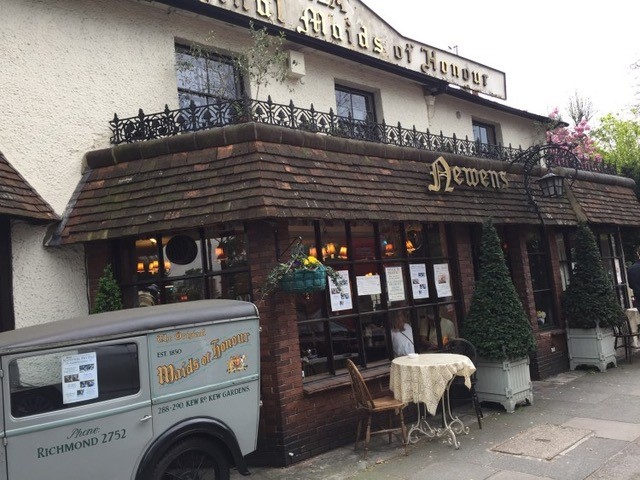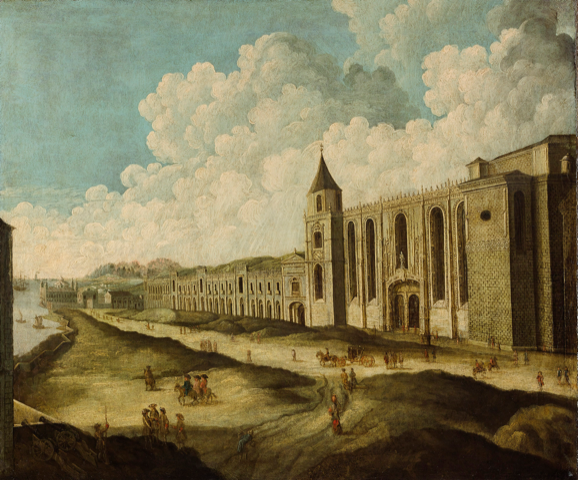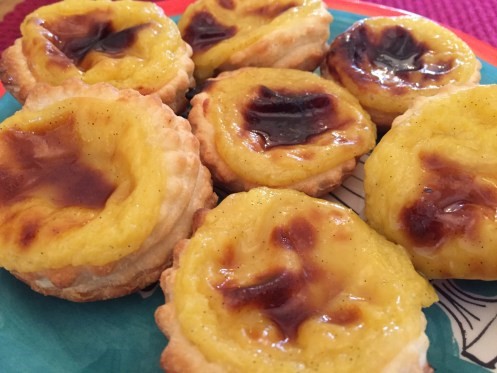Custard Tarts – Their Chequered Past, part 2
This is the conclusion of Di Murrell’s first guest essay for Know Your Place. If you missed Part 1, catch up here.
Whatever the truth of the tarts’ earlier history, their progress now begins to emerge into the realms of the verifiable. In 1750, Thomas Burdekin, a baker, began making and selling the tarts in a small shop next to the White Hart Inn in Richmond town. It is only about now that the story of custard tarts, with their royal connotations and delightful name, begins to circulate; the recipe purportedly stolen and sold to him by a lady of the court. One wonders: could this whole story ending with how the recipe came to be in his possession simply have been a clever sales ploy on the part of one Thomas Burdekin? After all, Richmond’s rise to prominence from the 14th century onwards had always been linked inextricably to the royal court. It had once had a famous palace and its royal connections lived on in the houses built upon its site known by then as Maids of Honour Row. The popularity of the town continued to grow, and had, by the 1800s, become a playground for the leisured classes and, increasingly, a magnet for tourists and day-trippers, who made their way up the Thames by boat from the capital in a matter of hours. What better way to mark the town’s illustrious history than with a little tart? It quickly became uniquely special: synonymous with one of most culturally evocative towns in the British Isles and providing a connection between its past glories and its cultural identity in more modern times. And what a good story too!
For Thomas Burdekin, his commercial production of the tarts was a great success and within 20 years he was able to expand into the next-door premises. In 1790 he sold his business (and presumably the recipe) and after it had passed through the hands of two further owners, by 1830, the latest proprietor was one John Thomas Billett. The Billett name became absolutely synonymous with Maids of Honour tarts and the famous shop front proclaimed that it was ‘the original shop of the Maids of Honour’. Grandfather, father and son in turn, welcomed those visitors to Richmond who had made the mandatory pilgrimage to their shop. On one memorable day, at the turn of the 20th century, some 8000 tarts were baked and sold.
In 1850, a young apprentice baker by the name of Robert Newens who had worked for the Billett family, opened his own bakery close by, where he too made and sold the tarts.
The Henry VIII-Anne Boleyn-Richmond Palace connection continued to circulate and gain traction and all the accounts one finds today are simply rehashes and embellishments of that particular story. One is inevitably forced to the conclusion that somewhere along the way, and well after Tudor times, the (dubious) association with Henry was kept alive simply to enhance the appeal of the tarts to the many visitors who came to enjoy a day out at Richmond.
Later in 1860 Robert Newens shrewdly moved his business from the centre of the town to new premises, complete with tearooms, perfectly situated opposite the entrance to the Royal Botanic Gardens at Kew. The tarts, now known as Richmond Maids of Honour, and whose recipe was once again proclaimed a family secret, soon became the mainstay of his business and hugely popular with the many visitors who came to Kew each year.
Yet, while that story surrounding them might be contentious, the fact of the existence of these popular little tarts from at least 1750 is not in doubt. The question remains: from whence did they spring? Are they no more than a version of an English custard tart appropriated, embellished and made his own by a canny baker called Thomas Burdekin, complete with romantic backstory, or can they be traced to another source entirely, or does the truth lie somewhere in between?

Perhaps that should be the end of it but on skipping swiftly back to Portugal we learn more of the little tarts known as Pastéis de Nata. These, it is said, were created sometime before the 18th century by Catholic monks who lived in the Hieronymites Monastery (Mosteiro dos Jerónimos) at Belém, not far from Lisbon. At the time, in the absence of manufactured laundry aids, convents and monasteries used large quantities of egg whites for starching their clothes, particularly the nuns’ habits. These monasteries and convents would then use the leftover egg yolks to make a variety of cakes, pastries and desserts. As a result, many sweet pastry recipes could be found throughout the country, that first emanated from the religious houses. The Pastel de Nata is just such a one: its outside casing is made with a crispy, flaky pastry, whilst the inside is a creamy, custardy mix, packing a sugary punch.
In the aftermath of Portugal’s Liberal Revolution in 1820, all religious institutions were being shut down and the resident clergy and labourers expelled. Desperate to stave off their imminent end and in order to bring in much needed revenue, the monks of the Hieronymites monastery began to sell the little pastry tarts in a small grocery shop attached to a nearby sugar cane refinery. At that time Belém was considered to be far from the city of Lisbon and was mainly accessed by steamboats; the grandeur of the monastery and the Torre de Belém (the Belém Tower) attracted visitors who enjoyed the delicious pastries that originated in the monastery. In 1834, the monastery was closed and the monks dispersed. They sold their recipe to the owners of the refinery and in 1837 the bakery known as the Fábrica de Pastéis de Belém was opened where the tarts continued to be made and sold. Their descendants still own and operate the business to this day.
Since its opening, the owners say that the original recipe of the Pastel de Nata has been kept in a secret room and remains unchanged. The Fábrica de Pastéis de Belém, is still the most popular place to buy Pastéis de Nata in the area of Lisbon. Rebecca Seal, the author of Lisbon: Recipes from the Heart of Portugal, explains that in peak season, the bakery makes up to 50,000 tarts a day. Other than that they are baked at 400C and use a milk-based custard, little else is known about how they are made. She says, ‘The recipe is kept a secret. Only to the family and the three people who make them know exactly how they are made.’
Could there really be any connection between the Richmond Maids of Honour and the Pastéis de Nata? Or is this just one big coincidence? Personally, I like the theory proposed by Clarissa Dickson Wright in her book, A History of English Food. She posits not that Catherine of Braganza introduced a Portuguese tart to the English court but rather that she took the English tart to Portugal. Her theory seems to cover all the elements: the tart could have been known in Tudor times; because of its expensive ingredients and sophisticated style of pastry it makes sense that it should have emanated from, and remained a speciality of the royal kitchen; the timing of its emergence and probable adaptation to commercial production in both countries seems to fit neatly. We do not know where the monks of Belém might have found their own recipe.
Some years after husband Charles’s death in 1685, Catherine had returned to Portugal to act as regent to heir to the throne, Pedro II. She remained there, running the country efficiently, until her death in 1705. Having enjoyed the tarts in England, Catherine could easily have returned to Portugal taking with her the recipe for making them. Certainly, sufficient time had passed for the tarts to have moved out of the rarified palace kitchen and into the public domain when Thomas Burdekin started producing them in 1750 in his shop in Richmond and the monks of the Jerónimos monastery at Belém began selling something very similar in 1834. With Queen Catherine as the link there is now a logical explanation for the fact that a remarkably similar confection should be found in the two countries.

The two tarts do seem related. They look much like each other, yet unlike any other. In both cases the pastry case is light and flaky and the contents sweet and creamy. The custard top is lightly browned. A comparative tasting of the modern versions of both suggests that there is one major difference between the two: the presence of curd cheese in the English version. The Portuguese tart is noticeably sweeter though it is difficult to detect the presence of rosewater or spices in either. Other significant differences are the baking temperature and the length of time spent in the oven. The Pastéis de Nata are baked at a significantly higher temperature for a much shorter period.
After so long, the actual facts probably no longer matter much. The ‘truth’ may be simply a matter of preference; that which one feels happiest with whilst still allowing for a little ruminative pondering. It would be satisfying to have arrived at some irrevocable sequence of events rather than a speculative interpretation based upon a balance of probabilities but in the end it matters little to one’s actual enjoyment of these tasty morsels. Indeed, a story much embellished and reliant for its subsequent acceptance on a sketchy acquaintance with historic fact, might as some would have us believe, actually enhance the whole eating experience.

The sufficiently keen can make their own comparison with a visit to the Newens’ Maids of Honour bakery and teashop at Kew and another to the Fábrica de Pastéis at Belém, in Lisbon, by the ancient monastery. Others who prefer to stay at home but are intrigued enough to want to bake their own, will find below two early recipes for an English puff pastry curd tart and a modern version. Though probably not the original one, there is also a recipe for the Pasteis de Nata. In taste and consistency, these are very similar to the little Portuguese tarts one can buy today.
Recipes
From The Accomplisht Cook by Robert May published in 1660:
‘To make a made dish of Curds.
Take some tender curds, wring the wehy from them very well, then put to them two raw eggs, currans, sweet butter, rose-water, cinamon, sugar, and mingle all together, then make a fine paste with flour, yolks of egs, rose-water, & other water, sugar, saffron, and butter, wrought up cold, bake it either in this paste or in puff-paste, being baked ice it with rose-water, sugar, and butter.’
From The New Art of Cookery, according to the present practice… by Richard Briggs first published in 1792.
‘Maids of Honour.
Take half a pint of sweet curds, beat them well in a marble mortar till they are as smooth as butter. Put in half a pint of cream, the yolks of four eggs, the whites of two, well beaten and strained through a sieve; a quarter of a pound of fresh butter melted, a little grated lemon-peel, and nutmeg, one ounce of candied citron shred very fine, a glass of brandy, and a spoonful of orange flower water; sweeten it to your palate with powder sugar, mix the ingredients all well together, have your patty pans very small, sprinkle on a little flour, put a thin puff-paste over them, more than half fill them, and bake them in a moderate oven.’
Maids of Honour Tarts – a modern recipe
It is thought that the original Tudor tart was filled with a sweet curd cheese filling, flavoured with spices and lemons, with a consistency not unlike cheesecake.
375g / 13oz puff pastry
50g / 1 ¾ oz softened butter
50g / 1 ¾ oz caster sugar
1 egg, beaten
1 tbsp plain flour
50g / 1¾ oz ground almonds
½ tsp grated nutmeg (or ground mace)
Zest of two lemons
100g / 3 ½ oz curd cheese
Preheat oven to 180C/160Fan/Gas 4.
You will need twelve-hole (or two six-hole) baking tray, greased and floured, and a 9cm / 3 ½ inch pastry cutter.
Roll the puff pastry out until it is slightly thinner than a one-pound coin.
Cut out twelve 9cm/ 3 ½in round pastry disks and use to line the baking tray(s)
Refrigerate the pastry-lined trays.
To make the filling:
Cream together the butter and sugar until light, pale and fluffy.
Beat in the egg, flour, ground almonds, nutmeg (or ground mace) and lemon zest.
Gently stir in the curd cheese. Be careful not to overwork the mixture here as it may split.
Spoon the mixture evenly into the pastry cases.
Bake for 25 minutes, or until the tarts have risen and are slightly brown on top.
Remove tarts from the tray(s) and transfer to a wire rack until completely cool.
This following recipe is an interpretation of the traditional Pastéis de Nata. Like the Maids of Honour tarts, the recipe is a secret but these do taste quite similar to the ones for sale in the shop at Belém. This adaptation was made by my friend Kay Gale, another local Richmond resident, whose food/travel blog travel-gourmet is very popular.
Pastéis de Nata
1 pack (320g) all-butter puff pastry
melted butter for greasing
Custard
20g butter
250ml whole milk
1 cinnamon stick
few strips lemon zest
2 tablespoons plain flour
1 tablespoon cornflour
2 egg yolks
1 teaspoon vanilla paste
Sugar syrup
225g caster sugar
1 cinnamon stick
few strips lemon zest
- Unfold the pastry onto a floured surface. Melt the butter and lightly brush the insides of a cupcake tin. Cut out 12 discs to fit the little moulds and push in well. Put in fridge to chill.
- Make the custard: put the milk in a small pan (saving just a little, about 50ml, for the next step) with the cinnamon stick and lemon zest. Bring slowly to a simmer. Turn off the heat. Leave to infuse for 10 minutes.
- In a bowl, mix the 2 flours with the reserved milk to form a paste. Remove the cinnamon stick and lemon zest from the warm milk and pour slowly over the flour paste, mixing as you go. Pour back into a clean pan with half the butter. Cook over a medium heat, stirring well, until you have a custard the thickness of double cream. (If it starts to go lumpy, remove from the heat and beat vigorously before carrying on.) Remove from heat and add the remaining butter, 2 egg yolks and vanilla paste. Beat well.
- Make the sugar syrup: put the caster sugar in a pan with the cinnamon stick and lemon zest. Bring to a rolling boil and boil until it goes a light caramel colour. Remove from the heat and pour, a little at a time, into the custard, beating well with each addition. At this is the point begin to add the syrup, tasting the mixture as you go. Stop when it is sweet enough for your taste. Keep what is left to brush over the tarts when they are cooked.
- Spoon the custard into the prepared pastry cases. About a dessertspoonful in each. There may be a little left over. Either make more tarts – or decide 12 are enough, and eat what’s left in the pan!
- Put the tray into a very hot oven (240C/220Fan/Gas 9) for about 10-13 minutes, or until the tops of the custard tarts are deep golden brown in places.
- Remove from the oven. Brush over a little of the leftover syrup to glaze the tops. Leave for a couple of minutes and then carefully transfer to a rack to cool.
Ideally, eat while still warm, sprinkled with icing sugar and cinnamon. Sadly, they lose their delicious crispness after a day.
Written by Di Murrell.
All images provided by the author.

Fantastic piece of research, and great recipes too. I cannot commend the writer enough.